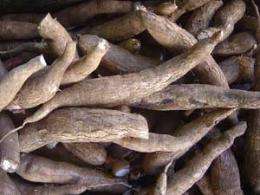Beware the smell of bitter almonds: Why do many food plants contain cyanide?

(PhysOrg.com) -- In murder mysteries, the detective usually diagnoses cyanide poisoning by the scent of bitter almonds wafting from the corpse. The detective knows what many of us might find surprising — that the deadly poison cyanide is naturally present in bitter almonds and many other plants used as food, including apples, peaches, apricots, lima beans, barley, sorghum, flaxseed and bamboo shoots.
There's a reason that cyanide exists in all these plants, and it is — to paraphrase Sherlock Holmes — evolutionary, suggests Kenneth M. Olsen, PhD, an assistant professor of biology in Arts & Sciences at Washington University in St. Louis.
Olsen, who studies white clover, cassava and other plants that produce cyanide, says the plants have an ingenious poison delivery system, one that evolution has designed to discourage herbivores from feasting on them.
Due to proper food processing techniques and strict regulations, cyanide-wielding plants pose little threat to the American food supply. But, in Africa, where cassava root has become a major part of subsistence diets, many poor people suffer from a chronic form of cyanide poisoning known as konzo.
How plants make cyanide
The plant stores the cyanide in an inactive form, typically as a cyanogenic glycoside, which is a sugar molecule with an attached cyanide group (carbon triple-bonded to nitrogen).
The cyanogenic glycoside is stored in one compartment of the plant cell and an enzyme that activates it is stored in another compartment. When an insect or other animal chews the plant and crushes the compartments, the two chemicals mix, and the enzyme cleaves the cyanide from the sugar. It’s a bit like breaking a glow stick to mix the chemicals that make the stick fluoresce.
Olsen describes it as “a cyanide booby-trap.”

What cyanide does to poison you (or the relevant herbivore) is equally ingenious. It prevents cells from using oxygen by binding in its place to the biomachinery that converts food to energy. This causes what is essentially a molecular form of asphyxiation.
And the molecular pathway it blocks is so ancient and universal, cyanide is effective against most life forms, from insects to people.
Why so many food plants contain cyanide
Why do so many food plants contain cyanide? There are two answers, Olsen says. Cyanide acts as a primitive pesticide that discourages insects that feed on plants. The very earliest farmers, selecting plants to bring into cultivation, might have found these “clean” plants particularly attractive. By selecting plants that hadn’t been chewed up by insects, they may have inadvertently selected ones that were cyanogenic.
But the second and perhaps more important reason is that as plant toxins go, cyanide is a manageable one. The cyanide in apples and peaches, for example, is in their seeds and pits, which are usually discarded.
In addition, Olsen says, even if an edible plant part contains the poison, it is easy to get rid of. All you have to do is crush the plant, then wash the mash. Crushing releases the water-soluble cyanide, which is carried off in the water.
Disabling the genes that code for cyanide production is also straightforward. It took only one genetic mutation, for example, to turn the toxic bitter almond to the benign sweet almond.
“You’ll notice that the oak hasn’t been domesticated,” says Olsen, “and this may be because the poison in that case is not a single compound but rather a broad class of compounds (the tannins) whose production is controlled by many different genes.”
“Many mutations would be required to generate a low-tannin oak. Also tannins are not sequestered in one part of the plant, such as the leaves, but instead are found throughout the plant, so it isn’t possible just to remove the offending part.”
“Squirrels have evolved digestive systems that can handle the oak tannins," Olsen says. "But tannins definitely discourage acorn consumption by people.”
The problem with cassava
One plant that can deliver problematic amounts of cyanide is cassava, also called manioc, tapioca or yuca.
Olsen, who has studied the domestication of cassava, says that it is native to South America and was imported to Africa by the Portuguese only 300 or 400 years ago. It remained a minor crop until about 100 years ago, becoming important only when soils became too degraded to grow traditional African crops.

There are sweet as well as bitter strains of cassava, but farmers often prefer the bitter, high-cyanide ones, because they discourage insects (and thieves — who avoid the roots that require laborious processing).
People have the ability to detoxify some cyanide if they ingest it slowly and over a long period of time, and if they have sufficient protein in their diet, particularly sulfur-containing amino acids.
Those who suffer from konzo are often subsisting on little other than cassava and may also not be processing the root properly, since detoxification requires an abundant water supply.
Tacked to Olsen’s office wall is a woven palm-fiber basket that looks like a giant Chinese finger trap. The purpose of this intriguing South American implement, called a tipiti, is to wring the cyanide out of grated cassava. It is also a reminder of the ingeniousness of plants, which are not the patsies animals often think they are, but instead experts in chemical warfare.
Provided by Washington University in St. Louis














